The Intricacies of Large Parrots: Features and Care
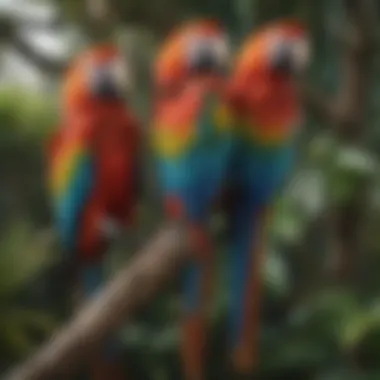
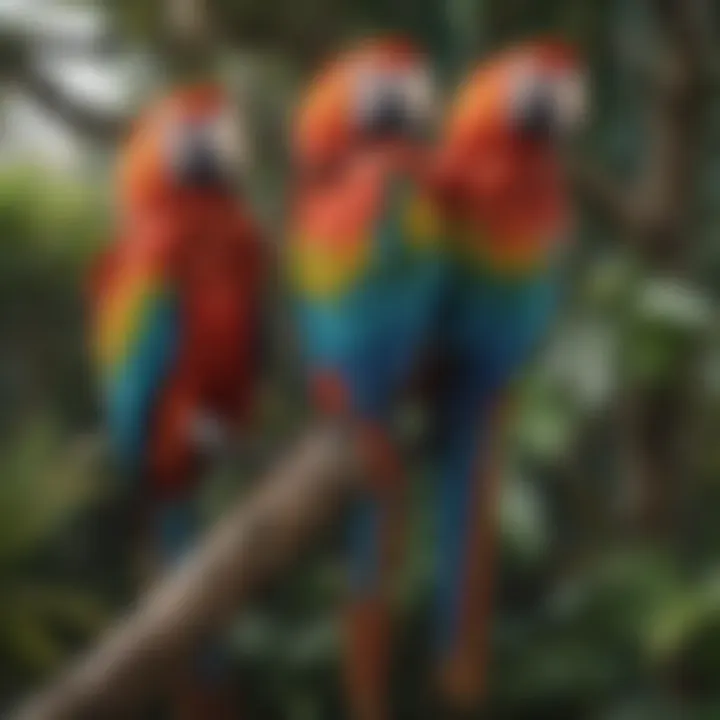
Intro
Large parrots, with their vibrant plumage and complex personalities, capture the hearts of many bird enthusiasts. Their presence enriches both our homes and ecosystems, making it crucial to understand their needs. This article provides an in-depth exploration of the stature of large parrots, examining the nuances of their care, behavior, nutrition, and overall well-being. As we embark on this journey, we will unravel the intricacies involved in creating a fulfilling environment for these extraordinary creatures, ensuring they thrive both physically and emotionally.
Care Tips
Caring for large parrots is more than just providing food and water. It requires a dedicated approach, tailored to meet their unique needs. Below are key aspects to incorporate into your daily routines:
Daily Care Routines
Daily care routines are vital for maintaining a healthy parrot. Spend time each morning checking their food and water. Fresh fruits and vegetables should be offered daily, alongside a balanced commercial diet. Observing their general behavior can also provide insight into their well-being. Do they seem lively or more withdrawn?
Cage Setup and Maintenance
A proper cage setup is paramount. Large parrots need space for movement and play. Aim for a cage that is at least two times their wingspan, allowing them to stretch and flutter safely. Include various perches, toys, and climbing structures that stimulate their physical and mental capabilities. Regularly clean the cage, removing droppings and uneaten food to prevent illness.
Hygiene and Cleaning Practices
Hygiene is an essential part of parrot care. Clean your bird's cage and accessories with pet-safe disinfectants regularly. Ensure that nails and beaks are in check as well. Routine grooming prevents health problems and ensures your parrot feels and looks its best.
Seasonal Care Adjustments
Seasonal changes can affect large parrots significantly. In colder months, provide additional warmth through heat lamps, while summer requires ensuring they stay hydrated and avoid overheating. Be mindful of drafts in your home which could disrupt their comfort.
Behavioral Insights
Understanding the behaviors of large parrots is crucial for building a positive relationship with them.
Understanding Bird Body Language
Birds communicate often through their body language. Watch for signs like ruffled feathers (indicating stress) or a relaxed body posture (showing comfort). Understanding these cues can foster better interactions and prevent potential behavioral problems.
Common Behavioral Issues and Solutions
Behavioral issues like feather plucking or excessive screaming can arise from environmental stress or inadequate stimulation. To combat this, ensure they have enough toys and social interaction. If issues persist, consulting an avian veterinarian is advisable.
Positive Reinforcement Techniques
When training your parrot, positive reinforcement works wonders. Treats or praise when they display desired behavior will encourage them. This method not only helps in training but also strengthens your bond.
Social Interaction Needs
Large parrots are highly social creatures. They thrive on companionship, both with their human caretakers and, if possible, other birds. Daily interaction and mental stimulation are essential to prevent loneliness and encourage a happy, healthy parrot.
Nutrition Guides
The right nutrition is foundational for all parrots but even more significant for larger species.
Essential Diet Components
Large parrots require a varied diet, including pellets, fresh fruits, vegetables, and occasional seeds. Pellets should form the core, supplemented with a rainbow of veggies like carrots, broccoli, and leafy greens.
Safe and Toxic Foods
While many foods are safe, others can be dangerous. For example, avocado, chocolate, and caffeine are toxic to parrots. Always double-check before sharing human food.
Supplements and Treats
Occasional treats are fine, but ensure they are healthy and appropriate. Nuts, for example, can be a delightful and nutritious reward, just remember to limit their quantity due to high fat content.
Feeding Strategies for Different Species
Different parrot species may require tailored feeding strategies. Researching the specific type of large parrot you have will provide clarity on their unique dietary needs.
Wellness and Health
Vigilance in health care goes a long way to ensuring your parrot's longevity.
Routine Health Checkups
Regular health checkups with avian veterinarians will help catch potential issues early on. They can also provide vaccinations and health advice specific to your parrot's needs.
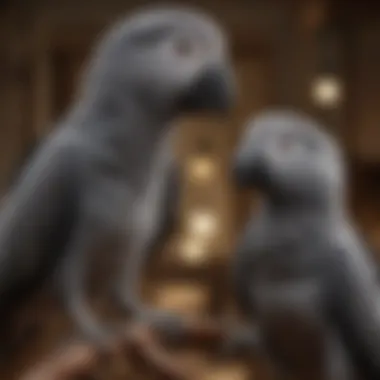
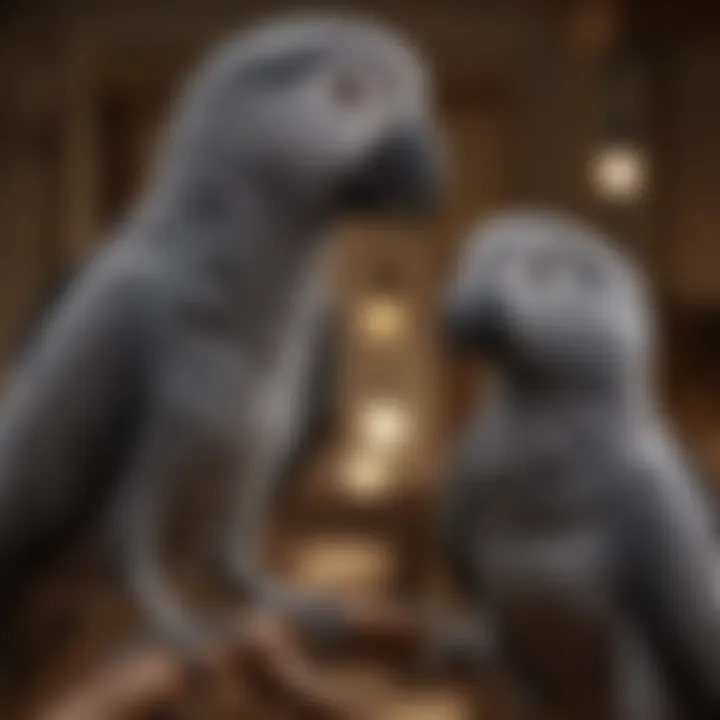
Identifying Symptoms of Illness
Being aware of subtle signs of illness is crucial. Changes in appetite, feather condition, or behavior might indicate health problems. If you notice anything unusual, do not hesitate to seek professional help.
Preventative Care and Vaccinations
Preventative care can save a lot of heartache. Ensuring your parrot is up-to-date on vaccinations can protect them from common diseases.
Mental and Emotional Well-being
A healthy parrot is not just about physical health. Ensure they have emotional stimulation through interaction, toys, and exploratory activities to enhance their quality of life.
Enriching Activities
Providing enriching activities can significantly improve your parrot's happiness and mental health.
Toys and Playtime Ideas
Invest in a variety of toys that encourage chewing, climbing, and problem-solving. Rotate them regularly to maintain interest.
Training and Tricks
Engaging in training sessions can offer mental stimulation while reinforcing good behavior. Simple commands can lead to complex tricks over time.
Outdoor Activities and Interaction
If you can safely do so, outdoor time is beneficial. Using a harness or a secure aviary can help your parrot enjoy the fresh air and new sights while being safe.
DIY Projects for Mental Stimulation
Crafting your own entertaining toys from wood, paper, or safe materials can save money and engage your bird creatively. Look up DIY ideas that cater to your parrot's size and preferences.
Remember, large parrots require a holistic approach to care that encompasses not just their physical needs but also their emotional and social well-being. Fostering a stimulating environment for them is essential.
Intro to Large Parrots
Large parrots are not just a breathtaking sight in the avian world; they hold significant roles that stretch far beyond their vibrant plumage. Understanding these remarkable birds is paramount for anyone who wishes to engage with them—be it as a pet owner, a bird breeder, or a simple enthusiast. This section sets the stage for a deeper exploration of large parrots, offering insights into their defining characteristics and their importance in broader ecosystems.
For people new to parrots, grasping the basic concepts of what constitutes a ‘large parrot’ lays the groundwork for deeper comprehension later. Large parrots differ from their smaller counterparts not just in size but also in personality, care needs, and distinct challenges. This foundational knowledge is vital as it equips one to tailor care practices that ensure both the health and happiness of these complex creatures.
Defining Large Parrots
When we think about large parrots, names like the Macaw and Cockatoo often pop into mind. However, what exactly categorizes a parrot as large? Generally, parrots that exceed 12 inches in length fall into the large category. Species like the Blue-and-yellow Macaw measure up to 40 inches, showcasing staggering crests and tail feathers that can catch anyone’s eye.
But size is just a part of the equation. Behavior and temperament also come into play. Large parrots are known for their playful and social nature, often forming strong bonds with their caretakers. This article will later discuss their social behaviors and intelligence, which adds a layer of depth beyond mere dimensions.
Importance in the Avian World
Large parrots occupy a unique and critical niche in the avian ecosystem. They are not merely pets or attractions in zoos; they actively participate in their natural habitats. Their roles include:
- Seed Dispersal: Many large parrots consume a varied diet that includes fruits and nuts, which makes them essential for plant reproduction.
- Ecosystem Indicators: Their health and population dynamics can indicate the overall health of their ecosystems. A decline in large parrot populations often signifies larger environmental issues.
- Cultural Significance: In various cultures, large parrots are symbols of beauty and intelligence, influencing art, mythology, and even spiritual beliefs.
Large parrots are among the most intelligent birds, capable of solving problems and mastering complex tasks. This intelligence is both fascinating and essential for their survival in the wild.
Through understanding both the numerical and qualitative importance of large parrots, we can better appreciate their role not just in captive environments but in nature itself. This lays the groundwork for the subsequent discussions about their physical traits, social behaviors, and the challenges they face in conservation efforts.
Next, we’ll delve into the physical characteristics that define these majestic birds, including their diverse sizes, stunning feathers, and distinctive beaks.
Physical Characteristics of Large Parrots
Understanding the physical characteristics of large parrots is crucial for anyone interested in these impressive birds. Their size, color, and unique features can significantly influence their care and habitat needs. As many pet bird owners or aspiring bird parents will tell you, recognizing what makes each species special helps in providing a sustainable and enriching environment for these feathered companions.
Size Variations Among Species
Large parrots come in various sizes, which can range from about 15 inches up to 40 inches or more. The most commonly known large parrots include the Macaws, Cockatoos, and African Grey Parrots. Each of these species displays different dimensions that influence their habitat and dietary requirements.
- Macaws are among the largest, with some varieties, like the Hyacinth Macaw, measuring over 3 feet in length. Their wingspan can reach 4 feet, making them a striking sight.
- The Cockatoo, on the other hand, can range from 12 to 24 inches, but their large crests and personality often make them feel more prominent in character than their size might suggest.
- In contrast, the African Grey, known for its intelligence, typically measures around 12 to 14 inches but carries a significant presence because of its cognitive abilities and social behavior.
These size variations not only dictate how much space a parrot needs but also affect their exercise requirements. Larger parrots generally need more room to fly and play, which can complicate their care if space is limited.
Feather Structures and Colors
Parrots are famous for their vibrant colors and unique feather structures. The coloration typically serves functional and aesthetic purposes. For example, Macaws possess brilliant blue and yellow feathers that not only assist in camouflage but also attract mates.
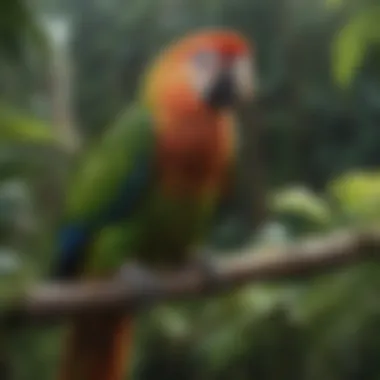
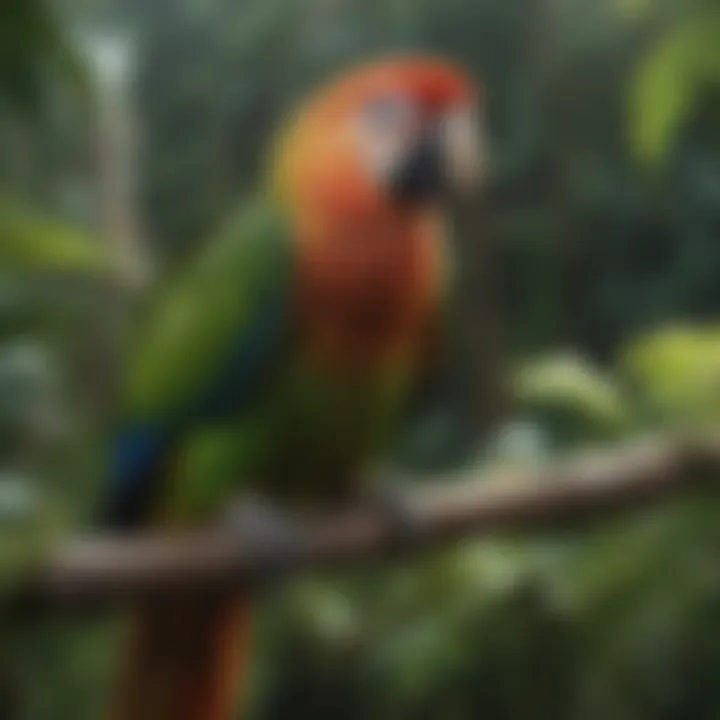
Respective to the structural aspects, feathers consist of several parts:
- Driving feathers or remiges aid in flight.
- Coverts, which lie on top of the wing, add to the coloring.
- Down feathers provide insulation, keeping the birds warm in cooler climates.
Many large parrot species have a sort of molting cycle, which typically occurs twice a year, marking the nautral replacement of old feathers with new ones. This process is crucial for maintaining flight capability and overall health.
Beak and Foot Differences
The beak and foot structures of parrots are specially adapted for their feeding habits and environmental interactions. Large parrots typically have strong, curved beaks suitable for cracking nuts and seeds, which form a significant part of their diet. For instance, the Scarlet Macaw has a beak that can exert a force which could easily crack a Brazil nut.
When it comes to feet, large parrots exhibit zygodactyl feet, where two toes face forward and two backward. This unique arrangement enhances their gripping ability, making them excellent climbers in their natural habitat. Their feet act almost like a third hand, helping them manipulate food and explore their environment.
Interestingly, the differences in beak shape and size can also reflect the dietary preferences of each species. For instance:
- Seed-eaters like the Amazon Parrot have strong, conical beaks.
- Flower-feeders such as the Eclectus show longer, slender beaks designed for reaching nectar.
"Understanding the physical traits of these birds enables better care, ensuring that they remain healthy and happy companions in human homes."
Overall, the physical characteristics of large parrots greatly influence their behavior, habitat needs, and care requirements. Recognizing these elements is foundational for anyone looking to welcome these magnificent creatures into their lives.
Behavioral Traits of Large Parrots
Understanding the behavioral traits of large parrots is pivotal to grasping their unique charm and adaptability. These traits not only illustrate their complex personalities but also highlight their needs and challenges as companions. Parrots are not just birds; they are social beings with emotions and intellect that often mirror those of humans. Recognizing their behaviors enhances the bond between the owner and the parrot, allowing for a more enriching environment. The following subsections delve into their social behaviors, intelligence, and playful nature, revealing the intricacies of their character.
Social Behavior and Communication
Large parrots exhibit a variety of social behaviors that are deeply rooted in their nature. In the wild, they thrive in flocks and rely on intricate forms of communication, which can be quite the spectacle. These vibrant creatures use a mix of vocalizations, body language, and even facial expressions to convey their feelings and establish social hierarchies.
Vocalizations range from soft coos to loud squawks, and each variation can signal different sentiments. Parrots often mimic sounds from their environment, adding flavor to their communication repertoire. Their ability to learn and replicate human speech is not just a party trick; it provides insights into their social needs. When parrots mimic their owners or repeat phrases, they may be expressing a desire for interaction or seeking companionship.
Effective communication is vital for both the parrot and the owner. Establishing clear communication methods often leads to better understanding and fewer behavioral issues. The bond formed through interactions not only promotes a sense of security for the parrot but also enhances the overall well-being of both companion and caregiver.
Intelligence and Problem-Solving Abilities
Large parrots are known for their sharp intellect. This intelligence is evidenced by their impressive problem-solving skills and ability to learn various tasks. Parrots have a natural curiosity, leading them to explore their surroundings and engage with objects creatively. Some species, like the African Grey Parrot, are particularly renowned for their cognitive capabilities.
Training exercises can be a great way to harness their intelligence. Owners can teach their parrots tricks, solve puzzles, or even engage in games using simple household items. For instance, hiding treats inside a puzzle toy encourages them to think and strategize about how to access the rewards. This mental stimulation is vital; without it, parrots may resort to destructive behaviors due to boredom.
Furthermore, their ability to understand concepts like numbers or colors showcases their advanced cognitive function, akin to that of a young child. Recognizing this intelligence can significantly impact how one interacts with these birds. Rather than merely providing a space and food, enriching their environment with challenges keeps their minds sharp and engaged.
Playfulness and Curiosity
The playful nature of large parrots cannot be overstated. Their curiosity drives them to investigate every nook and cranny of their environment, making them lively companions. This trait not only entertains their owners but also encourages a dynamic living situation where both human and bird can learn from each other.
Playtime is essential for parrots. Engaging them in activities such as climbing, swinging, or even water play can be incredibly fulfilling. Providing a variety of toys, from chewable to interactive puzzles, allows for an outlet of their playful energy. This variety can prevent boredom and encourage healthy behaviors.
Their curiosity often leads them to indulge in behaviors that may seem mischievous—like unrolling toilet paper or investigating a closed cupboard. While sometimes seen as troublesome, these actions are vital for their development and enrichment. Owners are encouraged to provide safe opportunities for exploration and play, ensuring that their feathery friends can express their natural instincts while staying safe.
"A satisfied parrot is one that can express itself freely through play and interaction."
In summary, the behavioral traits of large parrots, including their social interaction, intellect, and playful spirit, paint a rich picture of their complexity. Understanding and nurturing these qualities enables a deeper connection and a more rewarding experience for both the parrot and its owner.
Caring for Large Parrots
Caring for large parrots is an essential topic when discussing their stature and significance in our lives. These magnificent creatures bring vibrancy not just to our homes but also to our hearts. Understanding how to cater to their needs ensures they thrive, forging a bond that enriches both human and bird lives.
Essential Dietary Needs
Large parrots have specific dietary requirements that cater to their size, energy levels, and overall health. They thrive on a balanced diet that mimics what they would consume in the wild. Here are some dietary essentials:
- Pellets: High-quality, species-specific pellets should be the base of their diet. They’re designed to provide the necessary nutrients.
- Fruits and Vegetables: Fresh produce is crucial. Dark leafy greens like kale, broccoli, and bell peppers not only offer vitamins but also hydration.
- Nuts and Seeds: While tasty, these should be offered in moderation due to their high-fat content. Think of them as treats rather than staples.
It's important not just to focus on what they eat, but also how they eat. Large parrots love to forage, and providing them with opportunities to search for their food can keep them mentally stimulated. Combining their meals with interaction turns feeding time into a playful activity.
"A diverse diet is the key to a parrot's vibrant life, ensuring every colorful personality shines through!"
Habitat Requirements
Creating the right habitat for large parrots is vital for their comfort and wellness. Their environment should reflect aspects of their natural habitat, fulfilling their need for space and enrichment. Consider the following elements:
- Cage Size: Large parrots need ample space to move around. The general rule is that their cage should be at least two times the wingspan in width and height.
- Enrichment: Toys, perches of varying heights, and materials to chew on can keep them engaged. Rotate toys regularly to prevent boredom.
- Safety: Ensure the habitat is free from hazards such as toxic plants, open windows, or wires that could hurt them.
By designing a stimulating habitat that meets the parrot’s physical and psychological needs, you set the stage for a happy, healthy companion.
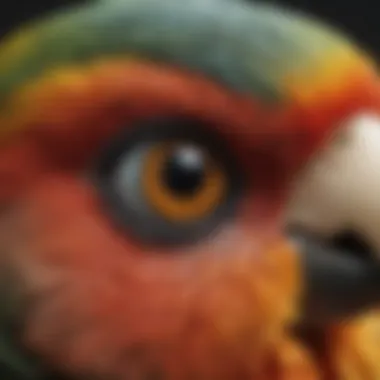
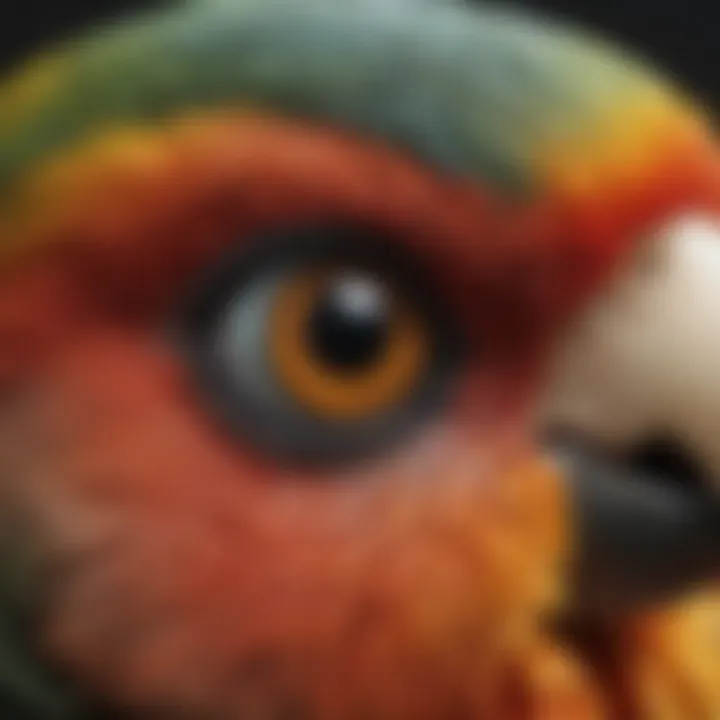
Health and Wellness Considerations
Regular health checks and a watchful eye on their behavior can be crucial. Parrots don’t always show when they are unwell, so being informed can help catch issues early. Here are a few pointers:
- Veterinary Care: Schedule regular vet visits every 6-12 months for health check-ups, especially for older parrots.
- Signs of Illness: Be aware of changes in appetite, droppings, or activity levels. These can be telltale signs that something is awry.
- Environment: Maintain cleanliness in their habitat, as parrots are prone to respiratory issues. Using non-toxic cleaners and avoiding aerosols can be beneficial.
Integrating these health considerations into the everyday care routine ensures these beautiful birds lead long, thriving lives.
Caring for large parrots isn't just about meeting their basic needs; it’s a profound commitment that requires attention, love, and ongoing education. As each parrot is unique, tailoring care to fit their individual preferences can make all the difference.
The Bond Between Parrots and Owners
The connection between parrots and their human owners is profound, often transcending mere companionship. This bond is important, not just for the well-being of the birds but also for shaping the experiences of their caretakers. Understanding the depth of this relationship reveals not only emotional layers but also practical implications for the care and management of these vivacious pets.
Understanding Parrot Emotions
Parrots are notable for their emotional depth. They experience a range of feelings, much like humans do. Observing the body language of a parrot can provide insights into its emotional state. For instance, when a parrot ruffles its feathers and makes soft cooing sounds, it may be expressing contentment. Conversely, if a parrot puffs up and screeches, it might signal distress or fear.
It's essential for owners to learn to interpret these cues. The key to a strong bond lies in understanding and responding to a parrot's emotional needs. By creating a safe and stimulating environment, human caretakers can help foster a sense of security, which in turn encourages a healthy emotional response.
Furthermore, not all parrots display their emotions the same way. Some might be more reserved, while others are downright exuberant. This variability challenges owners to adapt their approaches, embracing the uniqueness of each individual bird. A deeper insight into their emotions can lead to richer interactions, building trust and mutual respect.
Enhancing the Human-Parrot Relationship
Nurturing the bond with a parrot involves several strategies that promote interaction and understanding. Here are some ideas to enhance the relationship:
- Regular Interaction: Parrots thrive on social engagement. Spending quality time talking, playing, or simply being near them can strengthen the relationship.
- Positive Reinforcement: Use treats or praise to encourage desired behaviors, helping the parrot feel appreciated and understood.
- Understanding Play: Engage in play that mimics natural behaviors. For instance, offering toys that require manipulation or problem-solving caters to their innate curiosity.
- Routine Establishment: Parrots appreciate routine, which helps them feel secure. Regular feeding times and predictable interaction schedules can provide stability.
- Learning Together: Teaching a parrot new tricks not only stimulates their intellect but also reinforces the bond as they associate training with positive experiences.
"Parrots are not just pets; they are family members who come with layers of personality and emotion. Understanding and nurturing this connection is crucial for their well-being."
As owners invest time and effort into fostering a deeper bond, both the parrot and the human experience enriched lives. The companionship built through understanding and communication can be immensely rewarding, making it essential for potential bird owners to recognize and devote attention to this crucial aspect.
Ecological Impact of Large Parrots
Large parrots are not just captivating companions; they play a pivotal role in maintaining the health and balance of their ecosystems. Their impact is multifaceted, ranging from seed dispersal to serving as indicators of environmental health. For pet bird owners and aspiring bird parents, understanding these roles can deepen appreciation for their feathered friends and inform responsible ownership practices.
Role in Ecosystems
In their natural habitats, large parrots serve essential functions that extend well beyond their vibrant plumage and engaging personalities. They are often referred to as the "gardeners of the forest," primarily because of their role in seed dispersal. When parrots consume fruits, they do not just munch them down; they efficiently process the seeds and excrete them in different locations. This ability helps in the proliferation of various plant species, contributing to forest regeneration and biodiversity. The trees that these seeds sprout from provide habitat for numerous other creatures, illustrating a clear interdependence within the ecological web.
- Pollinator Helpers: Alongside dispersing seeds, many parrots also assist in pollination, particularly when they feed on nectar from blooms. As they move from flower to flower, they carry pollen, facilitating reproduction in flowering plants.
- Dietary Preferences: Parrots tend to eat a diverse diet, ranging from seeds and nuts to flowers and fruits, thus consuming and interacting with a variety of plant life. This dietary flexibility supports a wide range of ecological processes.
Their presence—or absence—can indicate the health of their ecosystems. A decline in parrot populations may suggest underlying environmental issues, such as deforestation or climate change, which can create a ripple effect, impacting many other species in the food chain.
"The health of ecosystems can often be gauged by the well-being of key species like parrots. Losing these birds can spell trouble for the entire community of plants and animals that depend upon them."
Conservation Challenges and Efforts
Despite their ecological importance, large parrots face significant threats in the wild. These threats come from various angles, including habitat loss, illegal pet trade, and the consequences of climate change. Understanding these challenges is crucial for conservation efforts and for bird owners who aim to advocate for their care.
- Habitat Loss: The destruction of forests for agriculture, urban development, and logging is a grave concern. Many large parrot species, such as the Spix's Macaw, have seen their habitats dramatically reduced, leaving them vulnerable.
- Illegal Trade: The allure of keeping exotic birds has led to rampant poaching. Many parrots are taken from their homes and sold illegally, leading to declining populations in the wild.
- Climate Change: As weather patterns shift and natural habitats change, this can affect food availability and nesting sites for parrots. Such changes challenge their survival and reproduction.
Efforts to conserve large parrots are underway across the globe, with many organizations working tirelessly to protect their habitats and promote breeding programs. Initiatives like the Parrot Conservation Program educate communities on the importance of preserving these birds.
By supporting these conservation efforts, pet owners and enthusiasts can help ensure that these magnificent creatures continue to thrive in their natural environment. Every small action counts, whether it's advocating for sustainable practices, participating in breeding programs, or simply educating others about the value of these vibrant avians.
Finale: Embracing the Complexities of Large Parrots
As we draw the curtain on our exploration of large parrots, it’s essential to recognize the multidimensional aspects that define these remarkable avian creatures. This conclusion not only encapsulates the key elements discussed throughout the article but also emphasizes the importance of understanding large parrots within the broader context of their existence in our lives and the ecosystems they inhabit.
Large parrots are not merely colorful companions; they embody a rich tapestry of behaviors, unique physical traits, and essential ecological roles. Their social nature and intelligence present both joys and challenges for their owners, whether individuals are seasoned bird enthusiasts or new pet parents. This article serves to remind us that each interaction with a large parrot is an opportunity to learn and deepen our bond, inevitably enriching our own lives.
"Understanding parrot behavior and needs deepens the bond between species and cultivates a more compassionate relationship."
Summary of Insights
Throughout this piece, we've uncovered several insightful aspects regarding large parrots. Consider the following:
- Physical Features: The distinct size, feather structures, and unique beaks of large parrots not only enhance their beauty but affect their behavior and care requirements.
- Behavioral Complexity: Their social structure requires considerable interaction, and understanding these dynamics is crucial for pet owners. Recognition of their intelligence leads to more meaningful engagement and stimulation.
- Ecological Role: Large parrots contribute significantly to biodiversity. Their habits, such as seed dispersal, make them vital for ecosystem health.
These insights reflect the nuances of interacting with these species and arrangements regarding ownership, fostering a better appreciation of their importance.
Future Considerations in Parrot Care and Conservation
Looking ahead, it’s crucial to consider both care practices and conservation efforts that will affect large parrot populations globally. Here are some pertinent factors to keep in mind:
- Sustainable Practices: Caregivers must advocate for sustainable sources of food and habitat practices to better align personal pet care with broader ecological efforts. This commitment will help diminish the impact of habitat loss.
- Education and Awareness: Increasing awareness about the unique needs of large parrots can lead to better care standards. Prospective owners should consider adopting from local rescues rather than purchasing from pet stores.
- Conservation Opportunities: Engaging in or supporting conservation programs dedicated to protecting wild parrot populations not only benefits the species but also enhances the understanding of their needs in captivity.
In summary, the exploration into the world of large parrots opens our eyes to their complexity. By embracing the challenges and rewards of large parrot ownership, we can pave the way for a bright future for both these wonderful birds and the ecosystems they inhabit. As we move forward, the collaboration between pet owners, conservationists, and the general public will be the cornerstone of ensuring that large parrots thrive in wild and domestic environments alike.















